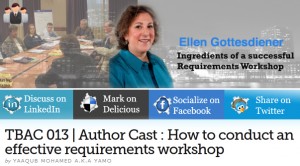Collaboration Works: Ingredients for Successful Workshops
 I’m honored to share my podcast with Yaaqub (Yamo) Mohamed of The BACoach. We discuss ingredients for effective requirements workshops described in my first book, Requirements by Collaboration: Workshops for Defining Needs.
I’m honored to share my podcast with Yaaqub (Yamo) Mohamed of The BACoach. We discuss ingredients for effective requirements workshops described in my first book, Requirements by Collaboration: Workshops for Defining Needs.
The ingredients are:
Ingredients about the People
- The Right People
- Wise Groups
- Trust
Ingredients about the Collaborative Process
- A Shared Purpose
- Shared Space
- Focus Questions
- Serious Play
- Process Variety
- Flexible Structure
- Frequent Debriefs
- Collaborative Closure
Ingredients about the Products
- Pre-Work
- Doneness Tests
- Using Both Sides of the Brain
As I listen to our discussion in this podcast about these ingredients, I am reminded that these ingredients are core to great teams (not just great workshops). Why? Because these ingredients engineer and sustain good collaboration.
Collaboration works. Good collaboration results in people who do quality work, delivered to agreed upon acceptance criteria. As I discuss in the podcast, trust saves time. Visualization enables shared understanding. Transparent decision rules and process are efficient. Teams that slow down to reflect on their products and processes improve, continually.
Requirements by Collaboration was published in 2002; the year after the Agile Manifesto was published. I had by then a few years working with agile teams (at the time, we referred to it more as iterative development). Back then and still today, one of my coaching responsibilities is to help agile teams collaborate effectively. Good facilitation practices are essential for agile (and really all!) teams. I draw on these ingredients constantly as a coach.
In the book, I wrote about “doneness tests.” This same expression (“done” or “doneness tests”) is now commonly discussed in the agile community. In the context of having people collaborating in a facilitated workshop, I wrote that you need to “establish a set of criteria…to judge whether each deliverables is complete, clear, and correct enough to be acceptable” (page 58).
This same ingredient is crucial to continual flow of business value on agile team. When we at EBG Consulting coach agile teams and are facilitating product backlog grooming or agile planning workshops, we facilitate processes so the team defines unambiguous acceptance criteria for each requirement (often in the form of user stories). We also use “doneness tests”—acceptance criteria—for Big-View, Pre-View, and Now-View plans. We teach these practices in our collaboration for agile teams training.
I hope you’ll find the podcast useful.
What ingredients for good collaboration would you add or amend to my list above?
Resources:
- Assets from Requirements by Collaboration
- Amplifying Collaboration with Guerilla Facilitation
- Three types of trust I mention in the podcast (contractual, communication, competency) originate with the Reinas. I highly recommend their book:
Trust & Betrayal in the Workplace: Building Effective Relationships in Your Organization, Second edition by Dennis Reina and Michelle Reina

Leave a Reply